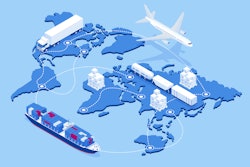
Supply chain disruption is inevitable in the modern global economy. One major reason? Our supply chains are more complex and intertwined than ever thanks to decades of outsourcing. Manufacturers today rely on large networks of international suppliers, which means very few organizations still operate in isolation.
Of course, there are benefits to this approach. Manufacturers can focus on their core competencies and offload ancillary activities. However, this doesn’t change the fact that there is risk in working with external partners, especially those who have their own dependencies to manage. We’ve seen this risk prominently on display over the last few years.
Between the COVID-19 pandemic, Russia-Ukraine crisis, supply and demand volatility and a now-looming recession, manufacturers have been through a lot. Many are still recovering and hoping for a return to normal at some point, but the reality is that we need a fundamental paradigm shift in how we manage our supply chain networks.
The only way forward, is forward.
So, what can manufacturers do to deal with almost-certain risk and disruption? Improve supply chain visibility and collaboration between all stakeholders through the power of technology.
How supply chain visibility paves the road to success
In the past, it made sense for manufacturers and suppliers to operate independently. These arrangements worked because both sides were able to focus exclusively on what they did best. And assuming manufacturers could reasonably forecast supply and demand, there was little need to monitor supplier activity closely. They could trust that their suppliers would deliver on expectations without much oversight. In an ever faster-moving world, however, forecasting and siloed operations lose some of their power.
Forecasting is most useful when supply and demand are predictable. When conditions are volatile, what matters more than forecasting is shared visibility. Visibility is about having real-time, or near real-time, insight into the entire supply chain. Visibility requires data accessibility and general openness between manufacturers and suppliers. The reason why visibility is important is because it enables informed decision-making and collective adaptability.
When manufacturers know what’s happening in their facilities and at their suppliers’ facilities, they can respond more effectively to unforeseen disruption. When suppliers also have this level of visibility, collaboration and creative problem-solving flourish. Each side can bring market intelligence and expertise to the table, knowing that they are working from the same data.
Visibility also breeds transparency, which is about understanding the context and driving forces behind real-world outcomes. To help distinguish transparency from visibility, consider a scenario involving a manufacturer with facilities on five continents. Visibility would mean knowing data points such as on-hand inventory, open capacity, current staffing and existing orders at each site. Transparency transcends visibility to help describe the “why” behind each of these figures– i.e.: “why is there more readily available inventory in South America than initially projected?” or “why is there less open capacity in the Asian facility?”.
When manufacturers have supply chain visibility and transparency, they can increase multi-enterprise agility– a key success factor in the modern global economy. In other words, these manufacturers can handle disruption better and even get ahead of it. Additionally, they can do this in partnership with suppliers. Everyone benefits from having greater access to data and more awareness of what’s happening across the supply chain.
What’s the easiest way to achieve this? Through advanced supply chain planning technology.
Supply chain technology underpins visibility and collaboration
Modern supply chain planning solutions give manufacturers the ability to consolidate and extend critical data to all relevant stakeholders. The best part is they can do this without having to pursue costly, large-scale digital transformation. Leading supply chain planning solutions can plug right into existing IT ecosystems and digitize much of what manufacturers have done by hand in the past.
Furthermore, supply chain planning solutions break down the barriers that have long kept manufacturers and suppliers from working together efficiently. Neither side has to overhaul on-premises technology or completely revamp the technology stack. Manufacturers simply have to implement a quality platform and then share access with partners, internal or external.
Modernizing supply chains in this way has tremendous potential for manufacturers going forward. First, they can replace manual methods of recordkeeping and data-sharing; stop keeping multiple, isolated spreadsheets for various functions like demand planning, inventory, capacity and orders. They can also move away from emails and phone calls to trigger events or update colleagues. All of this can happen in a digital system that is available to everyone, everywhere, so long as they have the right permissions.
The same benefits exist when it comes to engaging with external partners. Manufacturers and suppliers can work off the same reports and share data seamlessly when everything is available online. And both groups can participate in the creative problem-solving work that is essential for modern supply chain success.
For instance, demand planning analysts and their supplier counterparts can both see when orders should be adjusted or when inventory should be reallocated to address market changes. Manufacturers can evaluate supplier capacity more easily to determine the quickest production path. These are just a few examples of how a common supply chain planning solution creates more opportunity for collaboration.
To summarize, agility is the name of the game today and agility comes from having supply chain transparency that facilitates collaboration. As the world gets more complicated and interconnected, it’s these characteristics that will separate leaders from followers.
Disruption and change are everywhere. Consequently, we need tools that empower us to adapt to this new reality rather than hope for a return to normal that will never come. Manufacturers that internalize this lesson early will win in a post-pandemic world.














![Pros To Know 2026 [color]](https://img.sdcexec.com/mindful/acbm/workspaces/default/uploads/2025/08/prostoknow-2026-color.mduFvhpgMk.png?ar=16%3A9&auto=format%2Ccompress&bg=fff&fill-color=fff&fit=fill&h=135&q=70&w=240)


